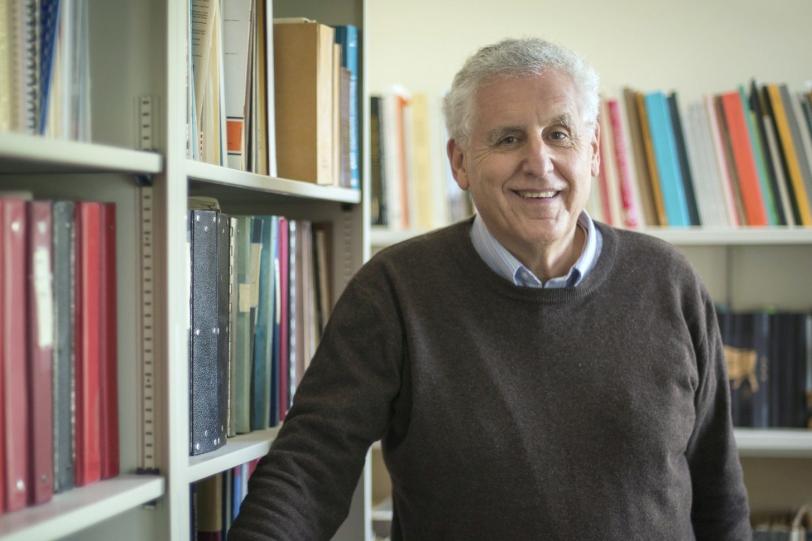SLAC’s Stanley Brodsky Shares Pomeranchuk Prize for Theoretical Physics
Researcher Is Recognized for Contributions to the Theory of the Strong Force
Stan Brodsky, a professor of particle physics and astrophysics at Stanford University and the Department of Energy’s SLAC National Accelerator Laboratory, has received the 2015 Pomeranchuk Prize from the Institute for Theoretical and Experimental Physics (ITEP) in Moscow, Russia. He shares the award with Russian physicist Victor Fadin.
“It is a great honor to be recognized for my physics contributions by such an eminent physics institute,” Brodsky says. “Over the years, the prize has been awarded to a number of truly outstanding scientists. This award is also a testimony to the quality of our theory group at SLAC.”
Each year since 1998, the award has gone to one international and one Russian researcher for their work in theoretical physics. Past recipients include SLAC’s Sidney Drell and James Bjorken as well as Stanford’s Leonard Susskind.
Brodsky is cited for three specific contributions to the theory of the strong interactions between quarks and gluons – the elementary constituents of particles like protons and neutrons. Precise knowledge of these interactions is crucial for studies of powerful proton-proton collisions at the Large Hadron Collider at CERN, the European particle physics laboratory, and for other experiments that illuminate our understanding of nature’s fundamental particles and forces.
Important Contributions to Particle Physics
The first accomplishment recognized by the Pomeranchuk Prize is Brodsky’s role in developing the rigorous description of hard exclusive processes using quantum chromodynamics – the theory of the strong interactions. In simple terms, this analysis computes scattering processes in high-energy particle collisions, for which all (as opposed to only some) collision products are measured. This approach, developed in collaboration with Cornell University Professor G. Peter Lepage, is widely used in the analysis of particle physics experiments around the world. Brodsky had previously received the 2007 J. J. Sakurai Prize for Theoretical Particle Physics for this work.
The Pomeranchuk Prize also honors Brodsky’s key contributions to renormalization techniques – mathematical methods that enable meaningful calculations of fundamental forces on the subatomic scale. Each renormalization technique depends in a particular way on the strength of the force involved. Brodsky and his collaborators have developed methods to make calculations independent of the choice of the renormalization method, thus removing a major systematic error in the analysis.
Last but not least, the prize recognizes the development of the light-front formalism of the strong interactions. Instead of describing the chain of events during particle collisions using ordinary time, as displayed by regular clocks, the approach uses the arrival time of light, rendering calculations independent of the motion of the particles.
“The light-front approach extraordinarily simplifies our calculations and describes the strong interaction in a very beautiful way,” Brodsky says. “Combined with a new method, called light-front holography, it also leads to new insights into how quarks are confined inside particles such as protons and reveals new symmetries that we didn’t know had existed.”
A Prolific Science Career
The ITEP prize committee mentioned only a few of Brodsky’s many outstanding accomplishments, which include over 600 scientific publications.
“The Pomeranchuk Prize is an important award honoring Stan’s extremely prolific research career,” says JoAnne Hewett, director of SLAC’s Elementary Particle Physics Division.
After earning a bachelor’s degree and doctorate from the University of Minnesota and completing postdoctoral research at Columbia University, Brodsky came to SLAC in 1966. He quickly advanced from research associate to permanent staff member in 1968 and became a professor at SLAC and Stanford in 1976. He led SLAC’s theory group from 1996 to 2002.
Brodsky has received numerous national and international honors. He is a fellow of the American Physical Society, a foreign scientific member and external scientific director of the German Max Planck Institute for Nuclear Physics, and the recipient of the 1987 Alexander von Humboldt Distinguished U.S. Senior Scientist Award, just to name a few. Brodsky has been a visiting professor at a number of universities and institutes in the U.S. and abroad, and is a member of many scientific boards and committees.
For questions or comments, contact the SLAC Office of Communications at communications@slac.stanford.edu.
SLAC is a multi-program laboratory exploring frontier questions in photon science, astrophysics, particle physics and accelerator research. Located in Menlo Park, Calif., SLAC is operated by Stanford University for the U.S. Department of Energy's Office of Science.
SLAC National Accelerator Laboratory is supported by the Office of Science of the U.S. Department of Energy. The Office of Science is the single largest supporter of basic research in the physical sciences in the United States, and is working to address some of the most pressing challenges of our time. For more information, please visit science.energy.gov.






